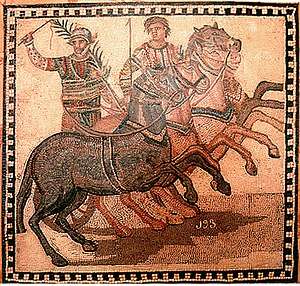Scorpus
Flavius Scorpus also known as Scorpius (c. 68–95 AD) was a famous charioteer in Roman times who lived at the end of the 1st century AD. Scorpus rode for the Green faction during his lifetime and accumulated 2,048 victories. As one of the most famous drivers in Roman history, Scorpus earned extraordinarily large amounts of money; his income surpassing that of professional Roman sponsors. Scorpus died young, at 27 years of age.
Scorpus | |
|---|---|
 Mosaic showing victorious charioteer with the victor's palm | |
| Born | c. 68 AD |
| Died | c. 95 AD (age 27) Rome |
| Occupation | Charioteer |
Scorpus was a slave, as were many charioteers, and was born at Hispania, the nowadays Iberian Peninsula. He received the laurel wreath many times, which is a symbol of continuous victory. Often at the end of a victorious game, fans threw him money. Eventually, he bought his freedom, becoming a libertus (freed slave).
Martial, a Roman poet, refers to Scorpus twice in Book X of his Epigrams, composed between 95 and 98 AD:[1]
Oh! sad misfortune! that you, Scorpus, should be cut off in the flower of your youth, and be called so prematurely to harness the dusky steeds of Pluto. The chariot-race was always shortened by your rapid driving; but O why should your own race have been so speedily run? (10.50)
and
O Rome, I am Scorpus, the glory of your noisy circus, the object of your applause, your short-lived favourite. The envious Lachesis, when she cut me off in my twenty-seventh year, accounted me, in judging by the number of my victories, to be an old man. (10.53)
Although the cause of Scorpus' death is unknown, it is likely to have been in one of the numerous crashes that occurred during chariot races, known as naufragia ("shipwrecks"). Charioteers wrapped the reins around their bodies in order to use their body weight to better control the horses. While this was extremely dangerous, the drivers carried knives that, in the case of an accident, would be used to cut themselves free. However, often after a crash the charioteers were unable to release themselves in time. Crashes often occurred near the turning posts, as shown in a circus relief in the Pergamon Museum in Berlin, which shows a fallen charioteer being trampled by another team.[2]
References
- "Martial, Epigrams. Book 10". Bohn's Classical Library. 1897. Retrieved 28 March 2013.
- McManus, Barbara F. (1999). "Scorpus". vroma.org. Retrieved 28 March 2013.
External links
- James Grout: Scorpus part of the Encyclopædia Romana
- http://www.vroma.org/~bmcmanus/circus.html
- https://earlychurchhistory.org/entertainment/scorpus-the-charioteer/